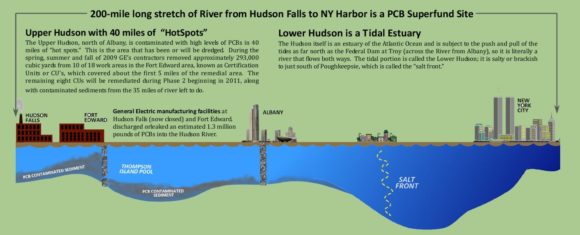Dear Commons Community,
New York State officials ripped the Trump Administration after federal environmental officials signed off on General Electric’s clean-up of PCB-tainted Hudson River sediment, with Gov. Andrew Cuomo announcing plans for a lawsuit over the decision.
The Environmental Protection Agency, ignoring the complaints of New York politicians and environmentalists, granted GE a “Certificate of Completion” for its $1.7 billion removal of 2.75 million cubic yards of PCB-contaminated river sediment north of Albany. Critics supported additional dredging to lower the level of contaminants.
“We take this effort seriously,” said EPA Regional Administrator Peter Lopez. “No person or organization will be let off the hook for the contamination of this historic and valuable waterway.”
Cuomo and state Attorney General Letitia James immediately declared plans for a lawsuit against the EPA over its decision regarding the tainted stretch of the 315-mile Hudson.
“We know PCB levels remain unacceptably high in the riverbed and in fish,” said Cuomo. “Since the EPA has failed to hold GE responsible for fulfilling its obligation to restore the river, New York state will take any action necessary to protect our waterways — and that includes suing the EPA to demand a full and complete remediation. Anything less is unacceptable.”
Cuomo said the White House “time and time again puts corporations and polluters’ interests ahead of public health and the environment.”
GE spilled and discharged tons of PCBs — or polchlorinated biphenyls — from its factories north of Albany into the Hudson decades ago. The final “Certificate of Completion of the Work” for GE is likely more than five decades down the road, the EPA said.
“The EPA’s decision today is a failure of leadership by the Trump Administration to protect clean water for New Yorkers who are demanding a full cleanup of the Hudson River,” said Sen. Kirsten Gillibrand (D-N.Y.).
Lopez said the remedial certificate did not rule out future dredging on the river.
“The dredging was very effective in removing the contaminated sediments,” added Lopez. “There are no hot spots in the Upper Hudson, only three localized areas of interest, as we call them.”
A GE statement said the EPA ruling confirmed that its clean-up project was a success, and the company promised to go forward with its Hudson River commitment.
“GE will continue to collect environmental data to assess ongoing improvements in river conditions and to work closely with EPA, New York State, and local communities on other Hudson environmental projects,” the statement said.
For those of us who live in New York, the Hudson River is one America’s remarkable waterways that was contaminated for decades by factories along its shores. G.E. was a major polluter and legally fought any attempts by state and local governments to assume any responsibility for the damage done. In 2005, G.E. agreed to dredge millions of yards of silt containing PCBs and other carcinogens. The question is whether the dredging was enough. According to the New York State Department of Environmental Conservation, the answers is no. G.E. is admired in some corporate circles but along the Hudson it is despised by many for what it did to our waterway.
Tony



